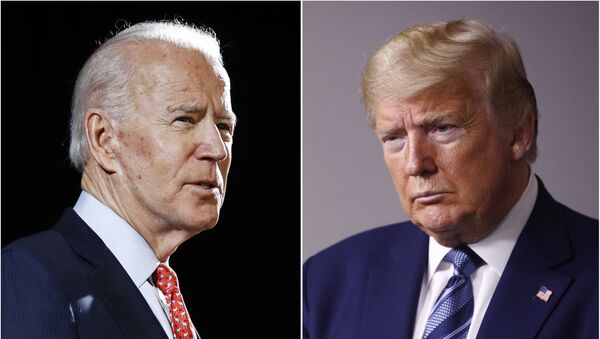Democratic presumptive nominee Joe Biden has gained a substantial advantage over Donald Trump in 13 key swing states, performing much better there than former Democratic hopeful Hillary Clinton did in 2016, election forecaster Sabato's Crystal Ball found in late May.
"The winner of the 2020 presidential election will be determined not by who wins the national popular vote but by who wins the most electoral votes in around a dozen states in which the outcome remains in doubt," the forecaster highlights, admitting, however, that election day is still more than five months away and a lot could change.
'I'm Not Going to Say This is Predictive'
The forecaster specifies that Biden is currently leading the incumbent president in Arizona, Colorado, Florida, Georgia, Maine, Michigan, Minnesota, North Carolina, New Hampshire, Nevada, Pennsylvania, Virginia, and Wisconsin by margins ranging from 0.3 to 17 points. In 2016, Trump carried seven of these 13 states, three of them with a very narrow margin.
Still, Gary Nordlinger, adjunct professor at the Graduate School of Political Management, does not share the election handicapper's enthusiasm: "I’m not going to say this is predictive until Biden is consistently polling around 52 or 53 percent in states like Florida or North Carolina. And he's simply not there yet", he says.
According to the professor, Americans are not really focused on the presidential campaign right now, and are caught in the middle between the COVID crisis and nationwide protests over the death of George Floyd.
"Also we don't know how the protests that are going on are going to affect Trump's standing. I'm anxious to see the next group of polls that come out, to see how that has helped or hurt Trump," he notes.
At the same time, he considers it surprising that Arizona is now regarded as a "swing state" because "for a long time that had been a reliably Republican state". According to Nordlinger, it may be the result of changing demographics and a growing Latino community, which traditionally votes for Democrats.
Still, although Trump has recently come under heavy criticism over the handling the COVID crisis and George Floyd protests, Biden "himself is not a perfect candidate", the academic admits: "He's 77 years old. He has a history of having, 'foot and mouth disease'. He has a history of saying things either in context or out of context". Besides this, "the Republicans have not really started their attack machine on Biden", the academic adds.
Two Crucial Factors: Job Approval and Favourability
There is no doubt that the current polls present Trump with an uphill battle, says Dr. Harvey Schantz, a political science professor at the State University of Plattsburgh. He notes, however, that in 2016, Trump won states and a district equalling 306 electoral votes, so "he can afford to lose up to 36 electoral votes and still have the 270 needed to win the election".
"If Trump lost Pennsylvania with twenty electoral votes and Michigan with sixteen, that would leave him with the magic number of 270," Schantz suggests. "Trump might be able to gain the closely fought state of Minnesota, with its ten electoral votes, but that is a number only large enough to offset Wisconsin, for it is one less than the eleven of Arizona. Biden has already shown electoral strength in the swing states of Michigan and Wisconsin by winning their presidential primaries over Senator Bernie Sanders."
Apart from the polls, there are two crucial factors determining who could come out on top, the academic notes: first, the president's approval numbers; and, second, the favourability of the incumbent and the challenger.
While Trump's average job approval rating, according to Real Clear Politics (RCP), is 43.6 percent, "which is a number too low to support re-election", the incumbent president and Biden have similar favourability numbers, at 41.6 and 43.9 percent, respectively, the academic emphasises.
"By comparison, in the 2016 exit poll, Hillary Clinton had 43 percent favourability compared to 38 percent for Trump, so Trump is more competitive with Biden in favourability than he was with Clinton on Election Day 2016," he points out.
Yet another indicator is the candidate's "trustworthiness", the professor continues. As a national 20 May Quinnipiac Poll of registered voters indicated that only 47% found Biden honest, the Trump campaign might be able "to bring down Biden’s favourability by assaulting his honesty", Schantz observes.
Partisan Divide is Deepening
The partisan divide is going to play out a lot in the coming elections, opines Anthony Pahnke, assistant professor of International Relations at San Francisco State University.
"People talk about the partisan divide. I think we’re seeing that now more than ever," he says. "There’s a different dynamic in each state. The big question is, right now - how is this partisan divide going to show up in the election? Meaning who can get out, who can turn out the people further in their parties. It’s the question about turnout."
The professor admits that the Americans are significantly polarised about the candidates: those who don't like Trump will vote for virtually any Democratic candidate; similarly, those who don't like Biden and Democrats will side with Trump despite all odds.
"That kind of anti-candidate position is pretty strong," he says. "I don't know if the anti-Trump feeling will get Bernie supporters to come out and vote [for Biden]. Like, for example, in 2016, there was a group of people in the swing states who were Bernie supporters - who went Trump. And that could happen very well again."
Even those who are protesting right now and striving for change won't necessarily cast their ballots for the former vice president, "since they can see Biden not as a solution, but part of the problem", Pahnke highlights, adding that many issues Trump is dealing with now were not sorted out during the Obama era either.




